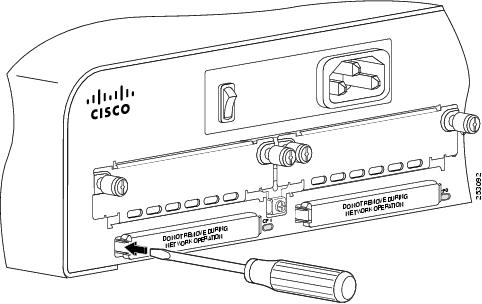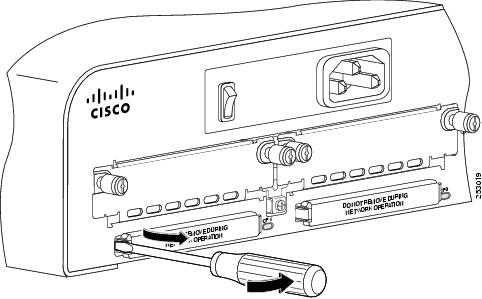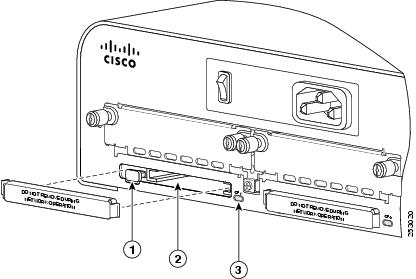Installing and Replacing CompactFlash Memory Cards
Available Languages
Table Of Contents
Installing and Replacing CompactFlash Memory Cards on Cisco 1900 Series Routers
Preventing Electrostatic Discharge Damage
Removing a CompactFlash Memory Card
Installing a CompactFlash Memory Card
Installing and Replacing CompactFlash Memory Cards on Cisco 1900 Series Routers
This document describes installing and replacing CompactFlash (CF) memory cards in Cisco 1941 integrated services routers. You can perform these procedures when the router has been installed in its working location with all power and interface cables connected. This document contains the following sections:
•
Preventing Electrostatic Discharge Damage
•
Removing a CompactFlash Memory Card
•
Installing a CompactFlash Memory Card
Preventing Electrostatic Discharge Damage
CompactFlash memory cards are sensitive to electrostatic discharge (ESD) damage. ESD damage, which can occur when electronic cards or components are handled improperly, results in intermittent or complete failures.
To prevent ESD damage, follow these guidelines:
•
Always use an ESD wrist or ankle strap and ensure that it makes good skin contact.
•
Connect the equipment end of the strap to an unfinished chassis surface.
•
Place a removed CompactFlash memory card on an antistatic surface or in a static shielding bag. If the card will be returned to the factory, immediately place it in a static shielding bag.
•
Avoid contact between the card and clothing. The wrist strap protects the card from ESD voltages on the body only; ESD voltages on clothing can still cause damage.
•
Do not remove the wrist strap until the installation is complete.

CautionFor safety, periodically check the resistance value of the antistatic strap. The measurement should be between 1 and 10 megohms (Mohms).
Removing a CompactFlash Memory Card
To remove a CompactFlash memory card from the chassis, perform the following steps. See Figure 8-2.

CautionDo not remove a CompactFlash memory card from the chassis while it is being accessed. The CF LED blinks to indicate when flash memory is being accessed. Removing the CompactFlash memory card from the router while flash memory is being accessed can cause data corruption and erratic operation.
Step 1
Remove the CompactFlash cover by placing a flat screwdriver in the slot and pushing sideways against the tension to release the cover door. (See Figure 8-1 and Figure 8-3.)
Figure 8-1

Inserting Screwdriver in to the CompactFlash Cover
Figure 8-2

Removing the CompactFlash Cover
Step 2
Press the ejector button next to the CompactFlash memory card. The ejector button moves outward so that it projects from the panel.
Step 3
Press the ejector button again. See Figure 8-3. This ejects the CompactFlash memory card part-way out of its slot.
Step 4
Pull the CompactFlash memory card out of its slot.
Step 5
Push the ejector button in until the button is flush with the bezel.

CautionTo prevent damage to the ejector mechanism, the ejector button must remain pressed all the way in (flush against the bezel) when not being used to eject a CompactFlash memory card.
Figure 8-3 CompactFlash Memory Card Slot in Cisco 1900 Series Routers

Installing a CompactFlash Memory Card
To install a CompactFlash memory card, perform the following steps (see Figure 8-3):
Step 1
Make sure that the ejector button is fully seated so that it does not project out from the panel.

Note
If the ejector button is projecting out from the panel, push it in until it is flush with the bezel.
Step 2
Insert the CompactFlash memory card into the slot until it is fully seated. The ejector button remains flush with the panel.

Note
If the ejector button is projecting from the panel after you insert the CompactFlash memory card, remove the CompactFlash memory card, press the ejector button until it clicks, and reinsert the CompactFlash memory card.

CautionTo prevent damage to the ejector mechanism, the ejector button must remain fully seated when not being used to eject a CompactFlash memory card.
Step 3
Replace the CompactFlash cover by pushing it in place until it snaps in place.
 Feedback
Feedback